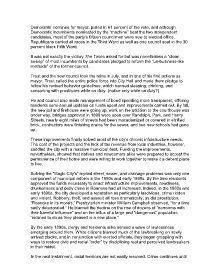Page 63 - A Narrative of the History of Roanoke Virginia
P. 63
Democrats’ nominee for mayor, pulled in 61 percent of the vote, and although
Democratic incumbents nominated by the “machine” beat the two independent
candidates, most of the party’s fifteen councilmen were new to elected office.
Republicans carried all races in the Third Ward as well as one council seat in the 30
percent black Fifth Ward.
It was not exactly the victory The Times asked for but was nonetheless a “clean
sweep” of most incumbents by candidates pledged to reform the “un-business-like
methods” of the former council.
Trout and the new council took the reins in July, and in one of his first actions as
mayor, Trout called the entire police force into City Hall and made them pledge to
follow his revised behavior guidelines, which banned sleeping, drinking, and
consorting with prostitutes while on duty. (notice only while on duty?)
He and council also made management of bond spending more transparent, offering
residents semi-annual updates on funds spent and improvements carried out. By fall,
the new jail and firehouse were going up, work on the addition to the courthouse was
under way, bridges approved in 1890 were open over Randolph, Park, and Henry
Streets, nearly eight miles of streets had been macadamized or covered in vitrified
brick, contractors were finishing drains for the sewer, and two new schools had gone
up.
These improvements finally solved most of the city’s chronic infrastructure needs.
The cost of the projects and the lack of tax revenue from local industries, however,
saddled the city with a massive municipal debt. Funding the improvements,
nevertheless, showed that natives and newcomers alike were prepared to accept the
permanence of their home and were willing to work together to make it a decent place
to live.
Solving the “Magic City’s” myriad street, sewer, and drainage problems was only one
component of municipal reform in the 1880s and early 1890s. By the time residents
approved the funds necessary to enact infrastructure improvements, rowdiness,
drunkenness and petty crime in Roanoke had all increased. Indeed, in the 1880s and
early 1890s, the city developed a reputation as particularly lascivious, crime ridden
and violent. Robbery, theft, and assault all rose dramatically, as did prostitution.
“Roanoke in its morals,” Presbyterian minister William Campbell observed, “for a time
sadly deteriorated.” He blamed the decline on the rise of dozens of “barrooms with
their baneful influence” and on the influx of a large and “dangerous” population
“inclined to do as they pleased in a new place.”
By the early 1890s, clergy and residents alike sensed a wave of lawlessness
emerging around them. White citizens blamed much of the lawbreaking on newly
arrived blacks, and in conjunction with elected officials, they began grappling with
ways to restore civic and racial “order” by disciplining real and perceived lawbreakers
in their midst.
In the next installment, racial tensions are not easily resolved. Crime continues until

